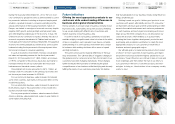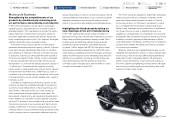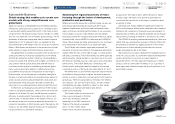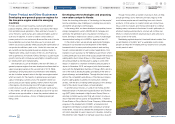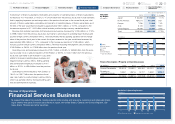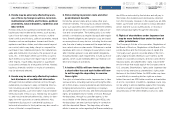Honda 2014 Annual Report Download - page 19
Download and view the complete annual report
Please find page 19 of the 2014 Honda annual report below. You can navigate through the pages in the report by either clicking on the pages listed below, or by using the keyword search tool below to find specific information within the annual report.
Japan
Total demand for automobiles in Japan*1 rose around 9%
from the previous fiscal year to approximately 5,690 thou-
sand units in fiscal year 2014. This was mainly due to sales
receiving a boost in the second half of the fiscal year from a
last-minute rise in demand before an increase in Japan’s
consumption tax rate. Gains were offset in part by a back-
lash from the termination of eco-car subsidies.
Honda’s consolidated unit sales in Japan rose 18.5%
from the previous fiscal year to 812 thousand units*2. This
result was attributable to the introduction of the N–WGN
and VEZEL and full model change of the Fit and Odyssey.
In production activities, Honda’s unit production of auto-
mobiles increased 6.9% from the previous fiscal year to 936
thousand units in fiscal year 2014, mainly due to higher sales
in Japan, despite the shift of some production overseas.
The Saitama Factory’s Yorii automobile plant, which had
been under construction in Yorii-machi, Osato-gun, Saitama,
began operation in July 2013. The manufacturing capacity
of the Yorii Plant, which mainly produces the Fit and VEZEL,
is 250 thousand units per year.
*1 Source: JAMA (Japan Automobile Manufacturers Association): (as measured by
the number of regular vehicle registrations (661cc or higher) and mini vehicles
(660cc or lower))
*2 Certain sales of automobiles that are financed with residual value-type auto
loans by our Japanese finance subsidiaries are accounted for as operating
leases in conformity with U.S. generally accepted accounting principles and are
not included in consolidated net sales to the external customers in our auto-
mobile business. As a result, they are not included in consolidated unit sales.
North America
Total industry demand for automobiles in the United
States*, the principal market within North America, rose
around 8% from the previous year to approximately 15,600
thousand units in calendar year 2013. This was mainly
attributable to improvements in employment conditions and
upswings in consumer sentiment that led to a substantial
increase in light truck sales and also a rise in small passen-
ger car sales.
Under these circumstances, Honda’s consolidated unit
sales in North America increased 1.5% from the previous
fiscal year to 1,757 thousand units in fiscal year 2014. This
was mainly due to strong sales of the Accord, Civic, CR-V
and other models, as well as a full model change of the
Acura MDX.
In production activities, Honda manufactured 1,777
thousand units, up 5.3% from the previous fiscal year.
Honda de Mexico, S.A. de C.V., a consolidated subsid-
iary in Mexico, built a new plant with an annual production
capacity of 200 thousand units in order to meet expected
market expansion for small cars in North America. This new
plant went into operation in February 2014.
* Source: WardsAuto
Europe
Total demand for automobiles in Europe*1 decreased roughly
2% from the previous year to approximately 12,300 thousand
units in calendar year 2013. The market diminished as a whole
due mainly to unemployment rates remaining high and the
weakness of the real economy in the eurozone, excluding the
U.K. The market’s decline was offset in part by an economic
recovery in the U.K., resulting in a pocket of growth in
demand for automobiles. On the other hand, total demand
for automobiles in Russia*2 decreased around 5% from the
previous year to approximately 2,770 thousand units.
Honda’s consolidated unit sales in Europe decreased 1.2%
from the previous year to 169 thousand units in fiscal year
2014. This was mainly due to a decline in unit sales of the Civic
which offset sales generated by the launch of a new diesel
engine equipped CR-V.
On the production front, unit output at Honda’s U.K.
plant declined 21.6% from the previous fiscal year to 133
thousand units in fiscal year 2014.
*1 Source: ACEA (Association des Constructeurs Europeens d’Automobiles (the
European Automobile Manufacturers’ Association)) New passenger car registra-
tions cover 27 EU countries and three EFTA countries, excluding Russia.
*2 Source: AEB (The Association of European Businesses)
N–WGN
(Japan)
Honda Motor Co., Ltd. Annual Report 2014 18
4 Review of Operations
1 The Power of Dreams
2 Financial Highlights
3 To Our Shareholders
5 Corporate Governance
6 Financial Section
7
Investor Relations
Information
Return to last
page opened
Go to
contents page


